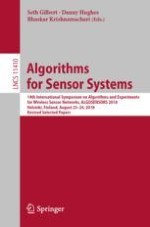This book constitutes revised selected papers from the 14th International Symposium on Algorithms and Experiments for Wireless Sensor Networks, ALGOSENSORS 2018, held in Helsinki, Finland, in August 2018.The 15 full papers presented in this volume were carefully reviewed and selected from 39 submissions. ALGOSENSORS is an international symposium dedicated to the algorithmic aspects of wireless networks. Originally focused on sensor networks, it now covers algorithmic issues arising in wireless networks of all types of computational entities, static or mobile, including sensor networks, sensor-actuator networks, autonomous robots. The focus is on the design and analysis of algorithms, models of computation, and experimental analysis.
